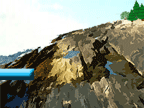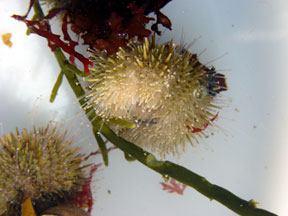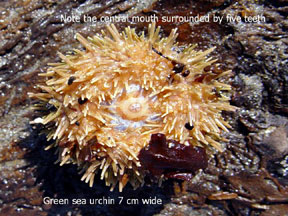 |
 |
|||||||||||||||
|
Kelp is grazed by a number of herbivorous invertebrates on the shore. The common periwinkle and tortoiseshell limpet will graze on kelp, particularly young shoots. However, the most important grazer is the green sea urchin, Strongylocentrotus droebachiensis. The green urchin prefers to reside subtidally in dense populations in kelp beds but it can also be found in lower tide pools when the tide goes out. This spiny pincushion of an animal can withstand high wave action by anchoring itself with hundreds of tiny tube feet. You can see them being used in the image above left. Urchins will often use their tube feet to grasp bits of debris like shell, rock, and plant fragments to cover their shell in an attempt to camoflauge themselves. The green urchin sits on the kelp to graze, using it's unique mouth. Centrally located on its underside, the mouth contains 5 teeth in a star-like arrangement. The entire mouth/jaw structure is referred to as Aristotle's lantern. Take a closer look by clicking on the image to the right above. |
||||||||||||||||
Did you know... |
||||||||||||||||
|
||||||||||||||||



